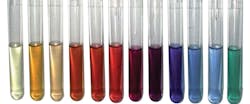Rainbow of variously shaped nanoparticles promising for live-cell studies
A simple synthesis method, developed by X. Nancy Xu and her research group AT Old Dominion University (ODU), is able to produce silver and gold nanoparticles in an array of shapes and a full rainbow of colors.1 The nanoparticles can infiltrate living cells or embryos, have potential for use as optical probes for the real-time study-which could help explain how cancers occur and how proteins work-and an array of them makes possible multiple, simultaneous biological probes.
The method produces probes that will remain stable over an extended period. The researchers have also reported breakthroughs in the way they image and characterize nanoparticles using dark-field optical microscopy and spectroscopy (DFOMS), which allows individual nanoparticles to be imaged and characterized in solution, instead of under vacuum using a transmission electron microscope. The potential applications require the sizes and shapes of individual nanoparticles to be characterized in situ, which is difficult to do at the nanoscale.
Xu's group has also studied the biocompatibility and potential toxicity of nanoparticles, aiming to rationally design probes that will not harm the cells or living organisms under investigation.
1. T. Huang and X.N. Xu, J Mater. Chem. (2010), doi: 10.1039/C0JM01990A
More BioOptics World Current Issue Articles
More BioOptics World Archives Issue Articles

